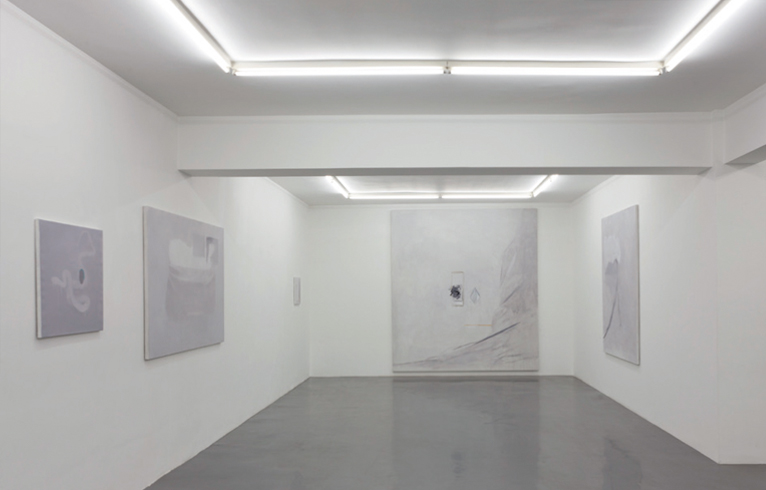ZHANG JBAI: I’VE GOT SOMETHING
| February 22, 2012 | Post In LEAP 12

The predominance of a grayish-white has always been the most salient feature of Zhang JBai’s paintings. Even his depictions of concrete subjects, such as his series of portraits, possess a certain imagery. In his new exhibition, “I’ve Got Something,” he continues to ruminate on this same faintly discernible spatial relationship on the canvas. His is a tone tinged with humor, which he initially used to form a kind of bond with the audience; however, this time, it looks a bit more like a game.
This is Zhang JBai’s first exhibition since returning from France and settling in China. Aside from an enduring partiality to the grayishwhite overtones, the representations of forms within his works are almost muted; everything he depicts seems to be withdrawing from reality. Interestingly, the audience’s discernment of the object of the artist’s portrayals has not been diminished in the least: this is the premise of Zhang Jbai’s technique. A correlation exists between the audience’s invariably lukewarm connection to the paintings and reality, such as with his works Toy Snake, Map, and Speech. Through the hints the works’ titles give and traces the artist leaves in the paintings, the audience can induce the artist’s true mood. During the viewing process, perhaps the audience will note this visual motif, and make the connection between the artist and the clean freak. We cannot be certain of the force and the intensity of what he portrays in this way. But we can at least know a little, from the indeterminate form of the gray-white, and from the distinctive spirit of the artist that unfolds while he creates his works: a buoyant and fluctuating mentality, patiently released from a purity of mind.
In creating a relatively tranquil painting space amidst the chaos of young people’s lifestyles today, it is difficult to render such strength of focus and calm. But artist Zhang Jiebai’s paintings must be a kind of willful forgetting of the burdens of everyday life. One can tell his practice is, to a large extent, detached from the process of testimony, and it stops at directly conveying his emotional state. This by no means creates some kind of specificity of form, but it does grant the audience an even broader scope of understanding, ergo, an experience generated by their own assumptions. This makes one think of the literary complex of traditional Chinese paintings, their fixation on scholarly figures, the particular attention paid to the molding of one’s state of mind, and the lingering poetics. This may be analogous to the state of Zhang JBai’s painting space, except that viewer assumptions also ascribe the works with a modern form of awareness of conflict.
In art history, during the nascence of fine art, there existed the “art as play” theory, whose proponents included German aesthetician Friedrich Schiller and the British scholar Herbert Spencer. Their efforts shaped the essence of art, constituting the sense of form and rhythm of its different forms. Taking a relatively relaxed attitude toward painting, the artist employs the rationality of individual values and attitudes toward objects, scattering them in bits among the forms of his works. Therefore, it is difficult to demarcate the emotional attributes of these paintings, and also to make out the original scenes on which they are based. In this respect, Zhang JBai blurs the painting of the quotidian with the painting of perception into one or several types of experience. He talks of “games,” yet this amounts to the self-creation of a sense of form; he talks of ideas, yet through restrictive definitions or descriptions reveals the value of emotions. Through this, his grasp of the seemingly illusory “soul” and “flesh” is very clear. Keeping distance from reality, Zhang JBai’s painting forms and refines its very own threads, woven by self-experience and self-feedback. Yu Qian (Translated by Caly Moss)

